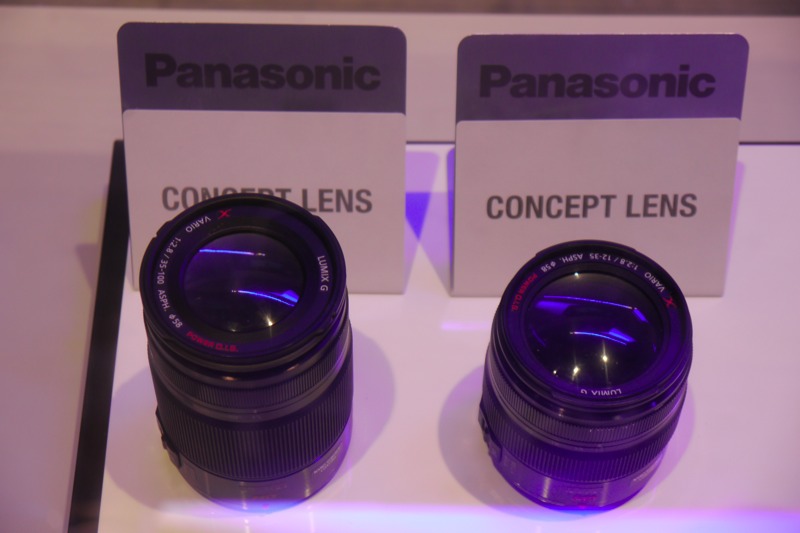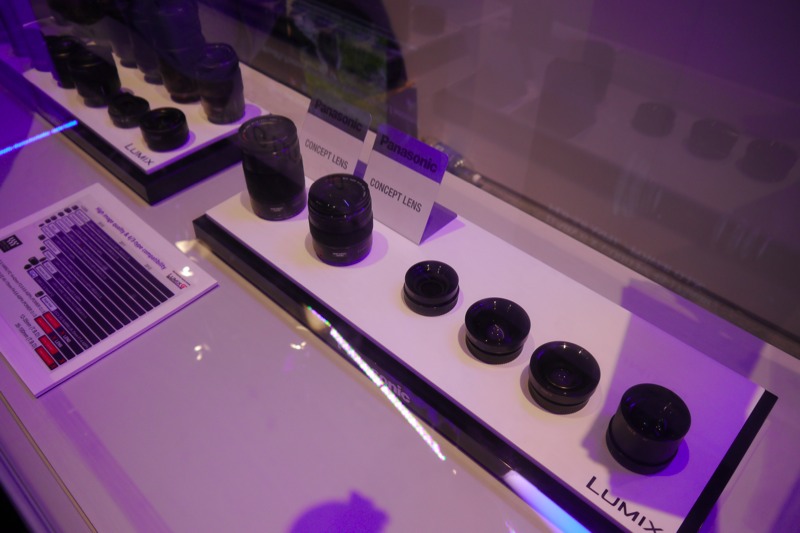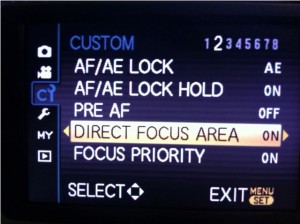The GH2 has one major design flaw. The four way controller. The ISO and WB button are way to easy to hit and screw up. I have found a solution. I went to the Menu button and when to the Custom menu. There turn on Direct Focus Area. This allows you to select the focus area with the four way controller. What it does not allow you to do is select the ISO or WB. Problem solved. When I accidentally hit one of the buttons I get the focus area which can be gotten rid of by hitting the Menu button again. I am a happy camper. (Why did Panny assign those button on a small camera?)
Author Archives: halfmac
New Micro Four Thirds System Partners
Micro Four Thirds lens choices is getting bigger. GH2 owners will need to watch to see what this brings.
 Olympus Imaging Corp. and Panasonic Corporation jointly announced the Micro Four Thirds System standard in 2008 and have since been working together to promote the standard. Now we are pleased to announce that three more companies have recently declared their support for the standard and will be introducing products compliant with the Micro Four Thirds System standard.
Olympus Imaging Corp. and Panasonic Corporation jointly announced the Micro Four Thirds System standard in 2008 and have since been working together to promote the standard. Now we are pleased to announce that three more companies have recently declared their support for the standard and will be introducing products compliant with the Micro Four Thirds System standard.
ASTRODESIGN, Inc., a developer of advanced imaging-related equipment, such as the 4K camera system, that incorporates the latest technology; Kenko Tokina Co., Ltd., one of the world's leading manufacturers and developers of interchangeable lenses for digital and film SLR cameras; and Tamron Co., Ltd., an internationally renowned manufacturer of precision optics who has been providing powerful, high-quality lenses for a wide variety of fields for more than half a century. With the addition of exciting new products from these companies, the Micro Four Thirds lineup will become much more diverse, further increasing the potential of this advanced digital imaging system.
As the originator of the Four Thirds System and Micro Four Thirds System standards, Olympus Imaging Corp. will continue to develop and enhance the product lineup for both standards to meet the diverse needs of our customers.
ASTRODESIGN, Inc.
 A Japanese company established in 1977 that designs and develops professional video equipment and measurement/analysis-related equipment. Well known for developing the world's first programmable signal generator and the Ultra HDTV image processor devices used at Expo 2005 Aichi, Japan.
A Japanese company established in 1977 that designs and develops professional video equipment and measurement/analysis-related equipment. Well known for developing the world's first programmable signal generator and the Ultra HDTV image processor devices used at Expo 2005 Aichi, Japan.
ASTRODESIGN, Inc. Website
http://www.astrodesign.co.jp/english/
Kenko Tokina Co., Ltd.
A Japanese company established in 1957 that designs and develops a wide variety of photographic supplies and optical products. It is Japan's largest manufacturer/seller of lens filters.
Kenko Tokina Co., Ltd. Website
http://www.kenkoglobal.com/
Tamron Co., Ltd.
 A Japanese company established in 1950 that designs and develops interchangeable SLR camera lenses, lens units for surveillance, as well as ultra-precision optical components based on the integration of advanced optical, electronic and precision machinery engineering technologies.
A Japanese company established in 1950 that designs and develops interchangeable SLR camera lenses, lens units for surveillance, as well as ultra-precision optical components based on the integration of advanced optical, electronic and precision machinery engineering technologies.
Tamron Co., Ltd. Website
http://www.tamron.co.jp/en/
The outlines of the standards can be checked at the Four Thirds website
http://www.four-thirds.org/en/
http://www.four-thirds.org/en/microft/index.html
A snapshot of our times
This article by George Will in the Washington Post is of importance to all photographers:
A snapshot of our times
By George F. Will, Published: January 18
LOS ANGELES
 Shawn Nee, 35, works in television but hopes to publish a book of photographs. Shane Quentin, 31, repairs bicycles but enjoys photographing industrial scenes at night. The Los Angeles County Sheriff’s Department probably wishes that both would find other hobbies. Herewith a story of today’s inevitable friction between people exercising, and others protecting, freedom.
Shawn Nee, 35, works in television but hopes to publish a book of photographs. Shane Quentin, 31, repairs bicycles but enjoys photographing industrial scenes at night. The Los Angeles County Sheriff’s Department probably wishes that both would find other hobbies. Herewith a story of today’s inevitable friction between people exercising, and others protecting, freedom.
When the Los Angeles Police Department developed a Suspicious Activity Report program, the federal government encouraged local law enforcement agencies to adopt its guidelines for gathering information “that could indicate activity or intentions related to” terrorism. From the fact that terrorists might take pictures of potential infrastructure targets (“pre-operational surveillance”), it is a short slide down a slippery slope to the judgment that photography is a potential indicator of terrorism and hence photographers are suspect when taking pictures “with no apparent aesthetic value” (words from the suspicious-activity guidelines).
One reason law enforcement is such a demanding, and admirable, profession is that it requires constant exercises of good judgment in the application of general rules to ambiguous situations. Such judgment is not evenly distributed among America’s 800,000 law enforcement officials and was lacking among the sheriff’s deputies who saw Nee photographing controversial new subway turnstiles. (Subway officials, sadder but wiser about our fallen world, installed turnstiles after operating largely on an honor system regarding ticket purchases.) Deputies detained and searched Nee, asking if he was planning to sell the photos to al-Qaeda. Nee was wearing, in plain view, a device police sometimes use to make video and audio records of interactions with people, and when he told a deputy he was going to exercise his right to remain silent, the deputy said: “You know, I’ll just submit your name to TLO (the Terrorism Liaison Officer program). Every time your driver’s license gets scanned, every time you take a plane, any time you go on any type of public transit system where they look at your identification, you’re going to be stopped. You will be detained. You’ll be searched. You will be on the FBI’s hit list.”
Nee is not easily discouraged — the first day he took photographs of street life, one of his subjects punched him — and has a bantam rooster’s combativeness when it comes to exercising his rights. He exercised them again, successfully, when police told him to stop photographing during an incident while he was standing next to Shania Twain’s star on the Hollywood Walk of Fame.
 Quentin, who finds aesthetic — and occasional monetary — value in photographs of industrial scenery at night, was equally persistent when deputies ordered him to stop taking pictures, lest they put his name on a troublesome FBI list. He was on a public sidewalk, using a large camera on a tripod, photographing an oil refinery at 1 a.m. He has a master’s degree in fine arts from the University of California at Irvine, so there.
Quentin, who finds aesthetic — and occasional monetary — value in photographs of industrial scenery at night, was equally persistent when deputies ordered him to stop taking pictures, lest they put his name on a troublesome FBI list. He was on a public sidewalk, using a large camera on a tripod, photographing an oil refinery at 1 a.m. He has a master’s degree in fine arts from the University of California at Irvine, so there.
Quentin — who in another incident was detained for 45 minutes in the back of a squad car — and Nee are not the only photographers who have collided with law enforcement. In conjunction with a Long Beach Post story on distracted drivers, a photographer went to a busy intersection to take pictures of people texting and talking on hand-held phones while driving. A courthouse was in the background; deputies called it a “critical facility,” so his picture-taking was “suspicious activity.” He was given a pat-down search, and deputies demanded to see the pictures he had taken.
On behalf of such photographers, Peter Bibring of the American Civil Liberties Union of Southern California has filed a complaint alleging violations of the First Amendment (photography as an expressive activity; freedom of the press is constitutionally guaranteed) and Fourth Amendment (unreasonable searches of persons and their cameras).
Bibring, not a stereotypical ACLU fire-breather, is sympathetic about the difficult decisions law enforcement officers must make concerning the shadowy threat of terrorism. “Points of friction,” he says equably, “are inevitable.”
As are instances of government overreaching in the name of security. Most seasoned law enforcement professionals, however, have sufficient judgment to accommodate the fact that online opportunities for the dissemination of photographs mean lots of people can plausibly claim to be photojournalists.
Furthermore, digital cameras — your cellphone probably has one — are so inexpensive and ubiquitous that photography has become a form of fidgeting: Facebook users upload 7.5 billion photos every month.
This raises reasonable suspicions not of terrorism but of narcissism, which is a national problem but not for law enforcement.
georgewill@washpost.com
Stop PIPA and SOPA NOW
Stop Internet Censorship Now. Call your elected officials. Tell them you are their constituent, and you oppose SOPA and PIPA. Why?
SOPA and PIPA would put the burden on website owners to police user-contributed material and call for the unnecessary blocking of entire sites. Small sites won't have sufficient resources to defend themselves. Big media companies may seek to cut off funding sources for their foreign competitors, even if copyright isn't being infringed. Foreign sites will be blacklisted, which means they won't show up in major search engines. SOPA and PIPA would build a framework for future restrictions and suppression.
In a world in which politicians regulate the Internet based on the influence of big money, websites cannot survive.
Congress says it's trying to protect the rights of copyright owners, but the “cure” that SOPA and PIPA represent is worse than the disease. SOPA and PIPA are not the answer: they would fatally damage the free and open Internet.
Go to:
Imaging Resource talks with Panasonic @ CES
Imaging Resource (Click here) had a long talk with MR. Darin Pepple, Senior Product Marketing Manager, Imaging at Panasonic Consumer Electronics Co. He was interviewed by Imaging Resource publisher Dave Etchells, senior editor Shawn Barnett, and features editor Arthur Etchells. Here is a section about the GH2 from the interview:
AE: What sorts of things might we see and what sorts of directions might Panasonic go with the successor to the GH2?
DP: Much has been talked about a successor for GH2. The GH2 has been out now for a little over a year, so people are wondering about the next model. There’s no one great thing I can say that we’re going to plan on and actually produce right at this time. Certainly, we’ll eventually produce something, right? But I think what you’ll see from us is to continue on trying to get a better and better and better video output for it. The GH product almost has a split brain. When I talk to people and I read the blogs–I participate once in a while on a few blogs just to see what people have to say–and there are two distinct worlds; completely right down the middle, video and still,at the high end. So you have a lot of people who are saying, ‘I just want it for its still camera capabilities. And it’s got great dials and accessibility.’ And then you’ve got the video world. They don’t care anything about that. They like the fact that it shoots amazing video; that you can hook boom mics to it; that you can hook it up as a director or videographer link through an HDMI cable; that it’s a lightweight platform. I see a lot of sports and action type photography–and I’m not talking about football, soccer, or that kind of thing; I’m talking about race cars–hooking it up to the bottom of a small, remote helicopter and flying it around, that sort of thing. It’s a lightweight platform and if it does get wrecked you’re not out the money you are out with a big DSLR rig system, let alone a conventional professional video system.
AE: A small footprint, in terms of both size and price.
 DP: Yes, and I think you’re probably going to see some more commercial applications in the future, such as wedding videographers–maybe they need a really great low light videography platform that maintains auto focus. Think about that, now: With a DSLR, if you’re going to go into a low light situation, such as a concert, where lots of laser lights are going and you’ve got the exposures changing constantly, you’ve got to track that exposure and change with it and you’ve got to somehow focus under low light conditions. That’s a lot to ask for from even a DSLR [or DSLR user] today. With our technology, with an X lens put onto it, it tracks like a proper video camcorder, for example, and it can adjust auto exposure in real time, following light changes really quickly. And at the same time, you’re getting just outstanding high-def quality video coming off of it. That, I think, is something that a mirrorless camera, or in our case the GH series, does really, really well.
DP: Yes, and I think you’re probably going to see some more commercial applications in the future, such as wedding videographers–maybe they need a really great low light videography platform that maintains auto focus. Think about that, now: With a DSLR, if you’re going to go into a low light situation, such as a concert, where lots of laser lights are going and you’ve got the exposures changing constantly, you’ve got to track that exposure and change with it and you’ve got to somehow focus under low light conditions. That’s a lot to ask for from even a DSLR [or DSLR user] today. With our technology, with an X lens put onto it, it tracks like a proper video camcorder, for example, and it can adjust auto exposure in real time, following light changes really quickly. And at the same time, you’re getting just outstanding high-def quality video coming off of it. That, I think, is something that a mirrorless camera, or in our case the GH series, does really, really well.
AE: So there has been a lot of interest in hacking GH2s. Might you take to heart some of those optimizations they're making when you're looking at future developments?
DP: You know… Yes and no? We do take a look at what they do, and we take it very seriously, because obviously that's what the customer wants. There are some limitations within the hardware and within the system specifications. For example, the AVCHD format; you know, we have to stay within the confines of what that AVCHD format says. Yes, you can go outside that with some hyped-up features and firmware updates and that sort of thing, but then you're outside the normal specification, and for us as a manufacturer, we really have to stay within it. At the same time, we know the level that the sensors can handle, we know the amount of cooling it's going to take, and to push it past it's limits, you're going to degrade the life expectancy of the product. Now, with a hopped-up camera, you somewhat expect that. You know, it's just like a car; if you push your car to the limit, you know something's going to happen eventually, right? So, as a consumer, go for it! But as a manufacturer, we have to stay within the limits of the standards and what we know the system itself can handle long term.
AE: So there's the caveat that you might be doing bodily harm to your camera…
DP: Hey, have fun; have a good time! Listen, that’s what photography’s all about anyway. I mean, how many photographers just take a product as is? They push it to the limits. That’s half the fun of photography. If you go back to the history of photography and you take a look at it, who started this stuff? Chemists, scientists, optics type people. They had a blast. It was a bunch of crazy technicians, that’s right. And if you take a look at the history of photography, it’s full of that. And I’m glad to see that that is still alive today. So I applaud them.”
Later about the the new X Lenses:
“DE: Is there a chart in the booth anywhere laying out a lens roadmap?
DP: We have two concept lenses in the booth. Both of them are conceptually the non-variable aperture types; a 12-35mm f/2.8 and a 35-100mm f/2.8.
DE: Yeah, basically the Micro Four Thirds versions of the classic 24-70mm and 70-200mm lenses; with constant aperture.
DP: When you do that [non-variable aperture], you do make the lens a bit bigger. Our concern has always been, ‘How do we keep the lens small and compact to stay in tune with the body styles of our cameras?’ After discussing it in great detail with the types of photographers who would really want a non-variable zoom, it turns out they don’t care. They want their non-variable zooms even if they have to be just a little bit bigger. So we’ve listened to that. That’s part of what we’ve been doing recently, showing the concepts around and saying, ‘Well, what do you think?’ Hands down, they say, ‘I’ll take it. I want it. Make it.’ “
Fotoshop
And now a break from CES news. Enjoy.
This is a very well done video. Shot on a RED One. http://jesserosten.com/

More CES – Fast Panasonic Zooms
Yes, that is right, the long rumored zooms have made an appearance. Here are the photos from CES 2012 that show a Panasonic Lumix Vario 12-35 F2.8 O.I.S and a Lumix Vario 35-100 F2.8 O.I.S. concept prototypes. These pictures are at Vitaliy Kiselev's site personal-view.com. He is responsible for the GH2 Hack.


These pictures are from the PhotograhyBlog.com


People are asking on DPreview why is Panasonic showing theses lenses and I responded:
“Some of you are missing what the these lenses are being make for. Another camera in the Panasonic 4/3d's line up is the professional AF100/101 video camera. As a user of one, it is really missing a good fast zoom. I have been using my Canon 24-105mm f4 IS with an adapter but it is even too slow and I can't use the IS as it has no power. The Lumix 14-140 is slower for inside shooting and not constant apertur,e but it has OIS. I want a f2.8 lens or faster with OIS for handheld.
These lenses will be great on my GH2 as well. If you want small, buy pancakes. If you need low light zooms use a bigger lens. The camera is still small. I have the 14 pancake for small and the Leica 25 for fast but neither has OIS. Even with these new lenses I will keep both of those lenses.
I can not wait to get my hands on them. Hopefully at NAB.”
They will great lenses for the frugal filmmaker.
LaCie Thunderbolt at CES
In one of the more interesting things coming out of CES 2012, Tech Tilt has a new video about the new LaCie Thunderbolt devices. The newest Thunderbolt device is an eSATA hub, which features 2 eSATA ports and 2 Thunderbolt ports, which allows for additional Thunderbolt devices to be daisy chained. Also in addition to the previously announced Little Big Disk, the LaCie 2big sports dual drives for a total of 4TB or 6TB capacities were shown. They should ship first-quarter 2012.
Check out the video below for a closer look.
A HDSLR that can hear better – The Nikon D4
 The Nikon D4 is the first to do something that no other HDSLR has done, added a headphone jack. This is in a large, heavy, expensive camera body, but it is a step in the right direction. Also including is a clean HDMI monitoring which is very big for those who want to record to an external recorder like the Atomos Ninja. Hopefully the HDMI out includes audio. The Panasonic GH2 was the first with that (but right now only at 60i with no audio).
The Nikon D4 is the first to do something that no other HDSLR has done, added a headphone jack. This is in a large, heavy, expensive camera body, but it is a step in the right direction. Also including is a clean HDMI monitoring which is very big for those who want to record to an external recorder like the Atomos Ninja. Hopefully the HDMI out includes audio. The Panasonic GH2 was the first with that (but right now only at 60i with no audio).
Here is a description of the video capabilities from DPreview:
“The parallel advances made in sensor technology and Internet video distribution have helped create the ability to capture and broadcast video footage. In turn this has put pressure on many professional photographers to capture clips alongside their stills. In addition, the broadcast and movie industries have adopted the 5D Mark II to a degree that appears to have surprised even Canon. As a result, it’s not surprising that the D4 features more advanced, and better integrated, video capabilities than its predecessor. The immediate giveaway should probably be the inclusion not just of a mic input socket by a headphone output for monitoring the results (both of which have adjustable input/output levels).
The D4 can shoot 1080p movies at 30, 25 or 24 frames per second and at up to 24Mbps. The video is compressed using the B-frame compression section of the H.264 standard, which tries to optimize the capture of motion without hugely inflating the file sizes. It also has manually configurable volume control, including a line-level audio option. However, what may prove to be the camera’s biggest feature is the ability to export its uncompressed video footage via its HDMI port. We suspect that this feature, beyond all others, may help endear the camera to the broadcast and movie crowd. Whether using this for recording the camera’s best quality footage or to use an external monitor as viewfinder, it’s a feature we expect to become increasingly common.
A number of small details show how carefully Nikon has listened to the needs of movie shooters, giving the option to start movies either with a record button or with the shutter button (which, in turn, allows video capture to be started with the 10-pin cable release). Photojournalists meanwhile, get to pick whether pressing the shutter interrupt the video capture to take a still or to take a full-frame 3:2 aspect ratio 2.5MP frame grab.
Movies can also be shot at three different crops from the sensor, which Nikon is describing as FX, DX and 2.7X (native 1920×1080). This makes it easy to vary the field-of-view for grabbing footage, even if you’ve got a prime lens mounted. However, the ‘FX’ size is a significantly cropped version of the full sensor (it’s 91% of the sensor’s width), so the field-of-view will be a little narrower than you’d expect for any given focal length. Also the native 1920×1080 video will be higher quality than the FX and DX versions, since it hasn't been downsized. This difference is likely to be incredibly small (almost certainly irrelevant for most users), but is a consideration for high-end video users.
The D4 gains improved aperture control in movie mode, with the addition of ‘Power aperture'. This simply means that the user can adjust the aperture while recording video in the A and M exposure modes. It's also possible to set the aperture much more precisely in video live view mode before recording starts, in 1/8 stop incrementss using the Pv and Fn buttons on the front of the camera. In principle this should allow more exact matching of recording brightness across multiple camera / lens combinations.”
– No mention of how it deals with moiré, ailising and rolling shutter. Also video has to be monitored with the back of camera LCD only because of the optical viewfinder is blocked by the mirror being up. The beast screams for accessories like an external viewfinder. Panasonic, please give the GH3 a headphone jack. –
Canon has apparently not yet received the memo
This is a great analysis of the camera industry today by Michael Reichmann over at The luminous-landscape.com.
“Canon has apparently not yet received the memo. Or, if they have, they have chosen thus far to ignore it. As a market leader in DSLRs they clearly have turf to protect. Those cameras and lenses carry higher margins than CSCs, though top of the line CSCs, like the NEX-7, clearly can be quite profitable if they become successes. The lesson that if someone is going to eat your lunch it may as well be you, seems not to resonate with Canon. But as all of the other companies scramble for position in the new CSC marketplace it is highly unlikely that can will sit on their hands for too much longer. The real question will be whether Canon decides to play it safe and follow Nikon with a very small sensor, or attack Sony, potentially Fujifilm, and to a lesser extent Panasonic and Olympus with a 2X or larger sensor.
But there is no question that the traditional DSLRs segment has lots of life left in it. It's a big “but” though, and its my belief that while pros and advanced amateurs in various fields (fashion, advertising, sports, wildlife, landscape) will continue to appreciate and demand the advantages that DSLRs have to offer, consumers and prosumers looking for versatility and image quality will increasingly be turning to CSCs. Smaller size, lighter weight and lower cost are the ingredients that appeal. And if a camera can also offer a large sensor (APS-C or MFT) than there is no serious compromise in image quality or availability of shallow DOF.
I'll close this out with a personal anecdote. Because of this web site, my workshops, seminars, writing and teaching, I meet and communicate with a lot of pros and advanced amateurs. We chat about photography, the industry, gear, and related topics. A year ago I hardly knew any that owned or even stated an interest in owning a CSC. But this is changing at a very fast clip. A great many are now saying that they've bought a Panasonic, Olympus or Sony Compact System Camera, and with the success and appeal of the Fujifilm X100 are hoping that an interchangeable lens version is under consideration from that company as well. I even know some serious photographers who are selling their DSLRs, and who are looking at advanced CSCs like the Panasonic GH2 and Sony NEX-7. Those that own legacy lenses also find these very appealing, since they can take virtually any lens ever made via adaptors.
Are we at the beginning of a new revolution? The entire world of photographic technology has been in a state of revolution for the past decade. The emergence of the CLC is simply another step in this evolutionary process. And with products like the Sony NEX-7, the category isn't going to remain an under-appreciated one for much longer.”
Yes we are at the beginning of a new revolution. I chose with my pocketbook by switching systems.












